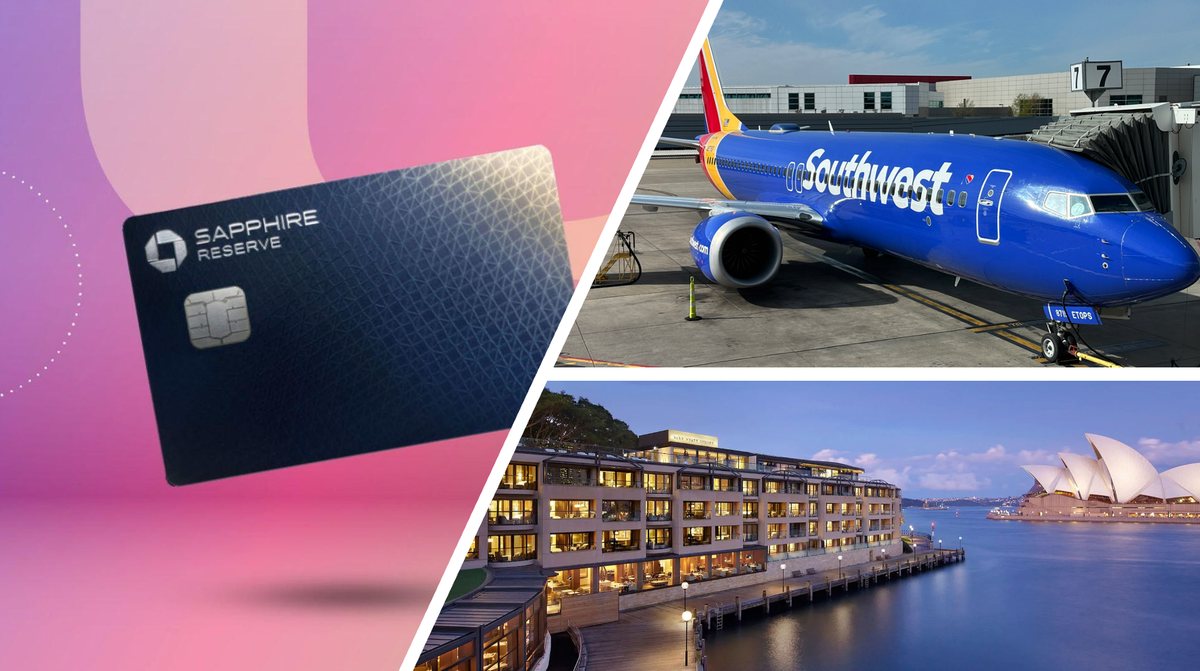You’ve Got 20,000 Chase Points - Here’s How to Actually Make Them Count
20,000 Chase points isn’t a small stash - it’s strategic. Used right, it’s a weekend in a Hyatt, a flight to Hawaii, or two cross-country tickets. Used wrong, it’s a $160 Amazon purchase. The gap? Knowing where to look—and when to transfer.


If You Only Had 60 Seconds to Read This Article (Click Here)
With 20,000 Chase Ultimate Rewards points, you’re sitting on more than just $200 in cashback. With the right partner redemptions, that small balance can unlock $300–$500 in travel, especially if you hold the Chase Sapphire Reserve (where the portal values points at 1.5¢ each). But the real value starts when you transfer to high-yield partners like Hyatt, British Airways Avios, or Southwest, where each point can stretch much further. At this level, you’re not booking bucket-list business class trips—but you can squeeze out 2–4 nights in solid hotels or even fly coast-to-coast for free.
Hyatt redemptions remain the standout at this tier. Award nights start at just 3,500 points (off-peak Category 1), meaning your 20k points could cover up to four nights in select properties like Hyatt Place or Hyatt House—often valued at $400–$500 total. Alternatively, 20k points could be used for a single night at a higher-end property (like a Category 5 or 6), offering a luxury experience at a fraction of the cash cost. On the flight side, British Airways Avios shines for short-haul domestic redemptions (as low as 6k–9k each way), or even a one-way to Hawaii from the West Coast for 20k Avios.
You can also unlock smart flight redemptions through Southwest, United, or Aeroplan. With Southwest’s revenue-based pricing, 20k points often gets you ~$280 in flights, and more if you hold the Companion Pass. United and Aeroplan both offer short-haul awards around 10k–12.5k miles one-way, so a domestic round-trip is within reach. And if you combine transfer bonuses (which Chase occasionally runs) with last-minute award space, it’s possible to extract up to 2.5¢ per point in redemption value, turning a modest balance into a major trip savings.
The biggest mistake people make? Cashing out or using UR points at poor rates—like 0.8¢ per point for Amazon or gift cards. Avoid low-value hotel programs like Marriott or IHG unless topping off a specific redemption. Always compare transfer vs. portal prices before booking, and never transfer points speculatively. With just a bit of research, 20,000 points can easily outperform their face value—and start you down the path of smarter, more strategic travel.
Everything else you need to know is just below 👇🏻
Solid Start to Go Wild
With 20,000 Chase Ultimate Rewards (UR) points, you have a solid starting stash to unlock valuable travel experiences. While 20k points won’t book a round-the-world trip, it can cover a long weekend getaway or a cross-country flight if used strategically. At this level, every point counts, so you’ll want to maximize value by focusing on high-yield redemptions rather than cashing out for a mere $200. The key is choosing between the Chase travel portal vs. transfer partners: you could redeem via the Chase portal for up to $300 in travel (if you hold the Sapphire Reserve at 1.5¢ per point) or transfer to airline and hotel partners for potentially outsized value. Let’s dive into how to make 20,000 UR points punch above their weight for travel.
Transfer Partners Overview (20k Level)

When you only have 20k UR points, choosing the right transfer partner is crucial. Not all partners offer great value at this tier. Here are the ones that matter most:
- World of Hyatt (Hotel) – Hyatt is the standout hotel partner for small balances. UR points transfer 1:1 to Hyatt, where award nights start as low as 3,500 points (off-peak Category 1). In practice, 20k points could get you 4+ nights at a Category 1 Hyatt Place or Hyatt House on off-peak dates – an incredible value, considering those rooms might cost $100+ per night. Even higher-end Hyatt redemptions are within reach (e.g. one night at a Category 5 hotel is 20k standard). Hyatt points consistently yield excellent value (often 1.5–2¢ per point or more), making this a top use for a small UR stash.
- British Airways Avios (Airline) – The Avios program (which includes British Airways, Iberia, and Aer Lingus) offers a distance-based award chart ideal for short-haul flights. With 20k UR points to Avios, you can book multiple short flights or even a one-way to Hawaii. For example: 20,000 Avios is enough for a one-way economy flight from the U.S. West Coast to Hawaii on American or Alaska. Avios redemptions for short domestic hops can be as cheap as 9k Avios one-way in economy (e.g. NYC–Miami or LA–Seattle), meaning 20k covers a round-trip. This is fantastic when cash fares are high. Iberia Avios also shines for transatlantic off-peak flights (more on that later).
- Southwest Airlines Rapid Rewards (Airline) – Southwest points are revenue-based (roughly ~1.3–1.5¢ value each), so 20k UR points to Southwest gets you about $280–$300 in flights. This can cover one or two one-way domestic tickets. The value is similar to using the UR portal (especially if you have Sapphire Reserve), but transferring to Southwest could be smart if you need to combine with existing Southwest points or take advantage of the Companion Pass (which lets a companion fly free). If you or a partner has the Southwest Companion Pass, 20k points can effectively double in value – covering $300 in flights for you and letting your companion fly free on those same bookings.
- United MileagePlus / Air Canada Aeroplan (Airline) – 20k UR points won’t go far for long-haul flights in these programs, but they can be very useful for short-haul awards. United’s domestic award prices are dynamic, often around 10k–12.5k miles each way for saver economy within the U.S. So 20k United miles (via UR transfer) can handle a round-trip domestic ticket or two short one-ways. Aeroplan, Air Canada’s program, has a generous award chart for short flights: trips under 500 miles cost only 6,000 Aeroplan points one-way in economy. For instance, transferring 12k UR to Aeroplan could book a round-trip hop like Toronto to New York. Also, Aeroplan points can be used on United flights without fuel surcharges. These programs are useful if you need flexibility or can’t find the flight via Avios.
- Other Partners to Consider: JetBlue TrueBlue – JetBlue points are roughly fixed at ~1.4¢ value, so 20k yields about $280 in flights, similar to Southwest. JetBlue’s strength is no blackout dates, so it’s an easy fallback if you find a good fare. Singapore KrisFlyer – Could be useful to book United flights (since Singapore is a Star Alliance partner) if United has saver availability; for example, domestic United flights cost 12.5k Singapore miles one-way in many cases. Transfers to Singapore aren’t instant (can take ~1–2 days), so plan accordingly. Marriott Bonvoy / IHG – These hotel programs have much lower point value (often <0.8¢). 20k UR to Marriott or IHG might fetch a $150 hotel night at best, so they’re generally not ideal unless you need to top off for a specific booking. (Even with occasional transfer bonuses, like a recent 65% bonus to Marriott, 20k UR ➜ 33k Bonvoy might cover a mid-range hotel night – still underwhelming compared to Hyatt).
High-Leverage Redemptions (Examples with 20k)
To get the most bang for your 20,000 points, target redemptions that deliver high value per point. Here are a few sample strategies and itineraries that overdeliver on value:
- Long Weekend “Hotel Hack”: Transfer 20k points to Hyatt for a few free hotel nights. For example, 20,000 Hyatt points = 4 nights at a Category 1 Hyatt (5k/night standard), which could easily be $400+ in value total. If you prefer something upscale, 20k could also cover one night at a Category 6 Hyatt (25k/night standard, or 21k off-peak). Imagine a night at the Park Hyatt Bangkok or Andaz Costa Rica (both Category 6) essentially for free – those often run $300–$500 per night cash. Even a Category 4 hotel (15k points standard) would leave you 5k points, which you could use for a future Hyatt night or upgrade. The hotel route is a great way to get a luxury experience or multiple budget stays from just 20k UR.
- Coast-to-Coast Flight in Economy: Got family on the other coast? 20k points can get you there. For instance, United frequently prices saver awards around 12.5k each way for transcontinental flights. If you find a United or partner saver seat, you could do New York to Los Angeles round-trip for ~25k United miles – a bit above 20k, but perhaps you use 20k and pay a small cash portion for one leg. Alternatively, transfer to British Airways Avios and book the same American Airlines flights: AA flights NY–LA can be ~13k Avios one-way (since it’s ~2,475 miles, falling in a mid-tier Avios band). That’d be ~26k Avios round-trip, but if you only have 20k, you could book one-way with points (13k) and pay cash for the other, or use points for both travelers one-way. The value shines if last-minute cash fares are high – an $350 one-way ticket could be had for 13k points + $5.60 in tax, yielding ~2.6¢ per point value.
- Hawaii on Points: As mentioned, 20k Avios can fly you from California to Hawaii one-way. For example, Los Angeles to Maui is 20k Avios in economy (40k round-trip). So while 20k UR won’t cover a round-trip, it covers half of a Hawaii vacation’s flights – you could use 20k for the outbound for two people (10k Avios each, if you catch off-peak pricing or a shorter West Coast route that’s ~13k round-trip per person). Pair that with a companion’s points or cash for the return. Given Hawaii flights often cost $400+, using 20k for one-way saves a lot. Another “sneaky” Avios redemption: Miami to Lima, Peru is 17k Avios one-way in economy. If South America is on your radar, 20k Avios can nearly get you a one-way to Peru (just 17k + ~$20 tax), which is fantastic for a five-hour international flight.
- Multiple Short Hops (Avios Short-Haul Awards): You can stretch 20k across several short flights. British Airways Avios charges as little as 6k–9k points for economy flights under 1,150 miles. For instance, Dallas to New Orleans is ~500 miles – just 6k Avios one-way (on American). Chicago to New York (~720 miles) might be 9k Avios. With 20k, you could book two or three such one-way hops. This is perfect for short weekend trips: e.g. a 9k flight to a regional destination, 9k back = 18k total round-trip (within your budget). Compared to cash prices which might be $150–$200 each way last minute, you’d be getting ~1.5–2¢ per point.
- Combining Points & Cash for Max Value: If your 20k UR points don’t fully cover what you want, consider a hybrid approach. For example, say a round-trip flight to the Caribbean costs 35k miles. You could transfer your 20k to an airline for one direction and pay cash for the other leg. Or use the 20k via the ChaseTravel.com portal to book $300 of the ticket cost and pay the rest out-of-pocket. This way, you still leverage your points for significant savings. A concrete case: a domestic U.S. round-trip might be $300. Use 20k points via Chase (if you have Sapphire Preferred, 20k = $250 in travel; with Reserve, 20k = $300) to cover the fare – essentially a free ticket aside from maybe taxes.
Booking & Execution Strategy
When deploying 20,000 UR points, a bit of planning ensures you extract maximum value:
- Plan Transfers Tactically: Because your points are limited, always find the award availability first before transferring. For instance, if you plan to use Avios for a flight, search for award seats on British Airways (for AA flights) or Iberia’s site (for Iberia/Aer Lingus flights) before you move your UR points over. Remember, once you transfer UR to a partner, you cannot transfer them back to Chase. So you want absolute certainty that those points will be used immediately for a high-value booking.
- Leverage Transfer Bonuses: Keep an eye out for Chase’s occasional transfer bonus promotions. These promos give you extra airline/hotel points for the same UR amount. For example, Chase has offered a 30% bonus to British Airways Avios in the past, meaning 20k UR would become 26k Avios – enough for an extra short flight. In June 2025 there was a 25% bonus to Virgin Atlantic and a 20% bonus to Aeroplan. If you’re not in a rush, a similar bonus to Avios or Hyatt could stretch your 20k considerably. That said, don’t hoard points indefinitely just waiting on a bonus. Use them when you find a great redemption; a bonus is just a nice cherry on top if timing aligns.
- Compare Portal vs Transfer Value: For each potential use, do a quick value comparison. Example: you find a domestic flight for $250 cash. Through the Chase travel portal, that would cost ~20k points with Sapphire Preferred (at 1.25¢ each) or ~16.7k with Reserve (1.5¢ each). If the airline wants 15k miles for the same flight, transferring UR might save you a couple thousand points (good). But if the airline wants 25k miles (because of dynamic pricing), you’re better off booking through the portal for 20k or less. Generally, below ~1.5¢ value per point, the portal is easier; above that, transferring is worth the effort.
- Booking Windows & Timing: Even with a small stash, timing your booking can improve value. If you’re planning a specific trip, try to book flights when the award calendar opens (usually ~330 days out for most airlines). At that point, saver awards (lowest mileage cost) are often available – perfect for using your limited points. Conversely, if you’re flexible and spontaneous, note that some of the best short-haul deals (especially Avios on American Airlines) can be booked last-minute without extra fees. British Airways Avios doesn’t add close-in booking fees (unlike how some U.S. programs used to), so you can snag a flight a day or two before departure for the same points price. This can be clutch if cash fares are surging.
- Stacking with Card Perks: Since we’re focused on redemption, we won’t delve into earning strategies, but do remember Chase’s “Pay Yourself Back” feature as a fallback. As of 2025, Pay Yourself Back allows Sapphire cardholders to use points for statement credits on certain categories (like charities or rotating options) at the same rate as the travel portal (1.25¢ for Preferred, 1.25¢ for Reserve on most categories currently). If you find yourself unable to travel, you could use 20k UR to wipe $250 of expenses (or $300 if a special category at 1.5x comes back). It’s not as exciting as a trip, but it’s better value than a basic cash out at 1¢. Also, remember you can combine UR points between cards and household members. If you have 15k and your spouse has 5k UR, pooling gets you to 20k for a redemption. Chase allows transfers of UR points to a spouse or domestic partner’s account (or an authorized user’s loyalty account) – handy when you’re just shy of an award cost.
Pitfalls & Red-Flag Redemptions
Even a modest sum of 20,000 points can be squandered if you’re not careful. Avoid these low-value or risky moves:
- Don’t Cash Out or Use for Gift Cards: It might be tempting to take $200 cash for your 20k UR (at 1¢ each) or redeem for a $200 Amazon gift card. Resist that! Those methods are the baseline minimum value. With a little effort in travel redemptions, your 20k could easily be worth $300–$400 in travel. Cashing out is basically settling for the floor value of your points. Unless you truly need the cash, put the points toward travel or Pay Yourself Back at enhanced value.
- Avoid Transferring to Weak Value Programs: As mentioned, transferring UR to Marriott, IHG, or other low-value programs is generally a poor choice at this level. For example, 20k UR to IHG gets you 20k IHG points – that might not even cover one night at a Holiday Inn (IHG now uses dynamic pricing and top-tier hotels can cost 40k–100k+ per night). Marriott’s dynamic award pricing can be similarly expensive; a high-end Marriott could be 80k points a night or more (your 20k UR -> 20k Bonvoy wouldn’t come close). Unless you have a specific top-off need – say you have 30k Marriott points and need 5k more for a booking – avoid dumping UR points into these programs for low-value redemptions.
- Beware Poor Portal Redemptions: The Chase travel portal values points at a fixed rate (1.25¢ or 1.5¢ depending on card). If a flight or hotel has an inflated cash price, using the portal could under-deliver compared to points transfers. For instance, a last-minute business class flight might be $800 cash but 25k points via portal (at 1.25¢). If that same flight could be booked for 15k United miles, transferring would be smarter. Conversely, if a flight is cheap in cash, don’t transfer points to an airline program that would charge a high fixed mileage price. Example: a $100 domestic flight might still cost 10k United miles (1¢ per point value – not great). In that case, just pay cash or use the portal for 8k points (with Reserve). In summary, bad redemptions to avoid include using points for very cheap flights or hotels (where you get <1¢ value), or transferring into a program for a redemption that you didn’t price-compare against the portal.
- No “Speculative” Transfers: This is key for any size UR balance, but especially with a small stash: do not transfer points without a plan. UR points are super flexible, but the moment you move them to one airline/hotel, you’re locked into that ecosystem. If your plans change or if award space vanishes, you could be stuck with points in a program that you might not use soon (and some airline miles expire if dormant). So avoid the mistake of thinking “I might use 20k in United later, let me transfer now.” Keep UR points untransferred until you’re ready to book.
- Buying Merchandise or Apple products with UR: Chase has options to redeem points for Apple products or shopping via Amazon/PayPal. These typically give horrible value (~0.8¢ per point). For example, 20k points might cover only $160 of an Apple purchase – you’re much better off using those points for travel and paying for the gadget with cash (or a credit card that earns more points!). In general, any non-travel redemption (besides Pay Yourself Back at boosted rates) is a red flag for UR points.
- Ignoring Taxes & Fees on Awards: If you do transfer to an airline like British Airways for a redemption, be mindful of additional charges. 20k Avios for Hawaii is great, but if you were using Avios for, say, a British Airways flight to London, you’d encounter $100+ in fees on an economy award (and far more in business/first). At the 20k level, you’ll likely stick to low-fee redemptions (domestic US flights have $5.60 security fee, and partners like Aer Lingus or American via Avios have minimal fees). Just keep an eye out so you’re not surprised by a $50 surcharge that eats into your savings.
Summary & Strategic Advice
At the 20,000 point tier, strategy and selectivity are everything. This is the realm of quick wins and clever travel hacks. What type of traveler benefits most here? If you’re an occasional traveler looking to offset a specific trip cost – like a weekend hotel stay or a domestic flight – 20k UR points can be a perfect, attainable target. It’s also great for the “sampler” traveler: you can try out a fancy Hyatt for a night or experience flying business class on a short route, without needing a huge balance.
When to burn vs. hold
Generally, 20k points won’t singlehandedly unlock ultra-luxury trips, so there’s less reason to hoard them long-term. You should feel comfortable using them for any redemption that clearly beats the cash value (remember our $300 portal benchmark). If you have a trip in mind where these points save you $300–$400, go for it. That said, don’t burn them impulsively on subpar redemptions. If you don’t have a good use yet, it’s fine to hold onto them – maybe you’ll earn more UR points to reach the next tier of redemptions (50k+) where bigger things open up. UR points maintain their value well, and Chase’s partner lineup is consistently strong.
Finally, see this 20k as part of your broader Chase strategy. You might have earned it via a Sapphire Preferred sign-up bonus or a few months of spending. Think about your travel goals: Is this 20k a one-off that you want to maximize now, or the start of a larger points journey? If it’s the former, we’ve shown you how to squeeze out a nice trip. If it’s the latter, maybe save these points and build on them – for instance, combine them with future earnings to reach the 50k or 100k level, unlocking even bigger rewards (like international business class).
In summary, 20,000 points, used wisely, can create $300–$500 worth of travel memories. Focus on high-value partners like Hyatt and Avios, avoid the pitfalls, and you’ll turn that modest UR balance into a fantastic travel outcome. It’s all about being savvy and strategic – qualities every points enthusiast prides themselves on.




